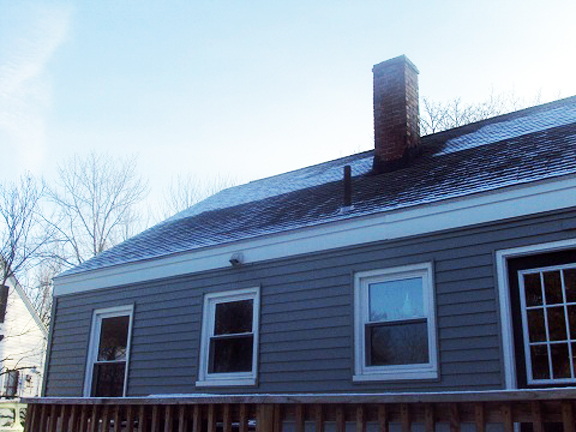
Image Credit: Erik North
When my wife and I bought our current house, one of the home’s appeals was that it was largely uninsulated. Given the choice between somewhat insulated and uninsulated, give me the blank slate every time.
We moved in in September, and because of a super-busy energy audit season and the need to unpack, any desired home-improvement projects were temporarily back-burnered.
We had our first big snowfall in December, and I soon saw just how leaky and poorly insulated our house was. The snow on the roof melted very quickly and soon formed 4-foot icicles obscuring the street view. For the balance of the winter, I kept a ladder, shovel, rake, and hatchet on the ready for snow, icicle, and ice dam removal.
Over the course of the winter, patterns emerged. We live in a Cape Cod home, with all of typical air-sealing and insulation problems for which Capes are famous. After blizzards, the snow would first melt around the chimney, and then from the roof over the kneewall crawlspaces.
The front of the house wasn’t soooo bad, as there is a high level of sun exposure. The rear was considerably worse. All told, the snow melt showed where the house had issues — and some pretty bad ones at that.
Snow melt as an audit tool
What I experienced first-hand and witness every winter day while driving is how snow melts and what it says about the house.
How fast did the snow melt? Is it freezing on the eaves and forming icicles? Is it forming ice dams? Is there a particular pattern to the snow melt that reveals clues about the house’s insulation? How does it compare with the neighboring houses (as they were likely built in the same era)? Is the snow on the ground melting away from the foundation?
So many clues, so little time.
How fast is the snow melting?
If I have a few hours, sometimes I will drive around neighborhoods and check out the snow on roofs. If one house has loads of icicles and ice dams, I’ll drop off a few business cards and brochures.
All snow will melt eventually. (Sitting on a dark shingle roof under direct sunlight is not conducive to a long frozen life.) However, comparing how quickly the snow is melting compared to other houses with similar construction and solar orientation can highlight those with more prominent insulation and air leakage issues.
Icicles and ice dams
Icicles and ice dams are indications of snow melt.
Ice dams form when snow higher on the roof melts then refreezes on the edge. If a house has heavy icicles and a nice thick ice dam, odds are very good that there are attic insulation and air sealing issues.
Melt patterns
The patterns that develop as snow melts on the roof are another clue. Check out the photo of my house at the top of the page; it was taken part-way through my efforts to air seal and insulate the house. I had blocked and sealed the tops of the kneewalls, but everything below the blocking was uninsulated.
Melt patterns can reveal a great deal about leaky chimney chases, unsealed vents, or recessed lights. (All of which are features which I don’t like.)
When you see signs of snow melt, you should ask this question: Where that heat is coming from? Melt patterns are often evidence of issues with air sealing and insulation.
Erik North, the owner of Free Energy Maine, is an energy auditor and home performance specialist in Westbrook, Maine. He is also the author of the Energy Auditing Blog.
Weekly Newsletter
Get building science and energy efficiency advice, plus special offers, in your inbox.











2 Comments
Natural energy auditing tools..
I've started to take lots of pictures of houses... with obvious insulation/air leaks. They make great show and tells when talking with people at meetings.
Early morning frost is also a wonderful all natural thermal imaging material....
I'm jealous of all those icicles... I loved them growing up as a kid... great sword fights... neat props for the snow forts...all before the dangers of such things were worried about.
We just don't get many four foot icicles in Seattle area...
If the house structure was properly designed.. and snow loads were considered for the roofs, is there really a need to rake the snow off the top? Or is that perhaps a winter myth that we pass on to each generation.
I can see the desire to knock off the icicles.... they can add a lot of weight concentrated on the gutters -- and possibly hurt small kids below them.
But in modern houses -- are the roof structures not rated for 50 year snow loads?
Superinsulated Retrofit Snow Melt Blog Post
Nice post! I worked with a team doing an early deep energy retrofit on a house in Arlington, MA--one of the things that gave the homeowner a chuckle was walking down the street, and comparing snow melt patterns on his roof with his neighbors: http://superinsulating.blogspot.com/2009/01/snow-melt.html
Log in or create an account to post a comment.
Sign up Log in